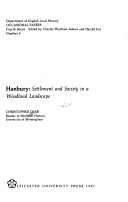English Local History , 4th S.
1 total work
Local history has contributed more than any other field to the development of a wide range of techniques applied intensively to the understanding of historic and prehistoric ways of living. In this new study a range of archaeological and documentary techniques are combined to show how the land has been settled and cultivated over a period of more than 4000 years. The medieval and modern woodland landscape is shown not to be a survival of primeval forests but the end product of constant change. Periods of extensive cultivation have alternated with periods of retreat when the corn fields have reverted to wood and pasture. The layout of houses and fields has been related to the society of the woodlands, so this book is about serfs, poachers and alehouse keepers as well as the buildings in which they lived, and the open fields, woods and meadows in which they worked. Social history helped to explain the development of the landscape, because throughout history people - peasants as well as kings and lords - made choices about where they lived and how they worked the land.
This book will interest readers in the Midlands and elsewhere in England who know Hanbury and will also be appreciated by all those interested in the history of settlements and the landscape. Important general conclusions about the history of the countryside are drawn from a detailed example.
This book will interest readers in the Midlands and elsewhere in England who know Hanbury and will also be appreciated by all those interested in the history of settlements and the landscape. Important general conclusions about the history of the countryside are drawn from a detailed example.
